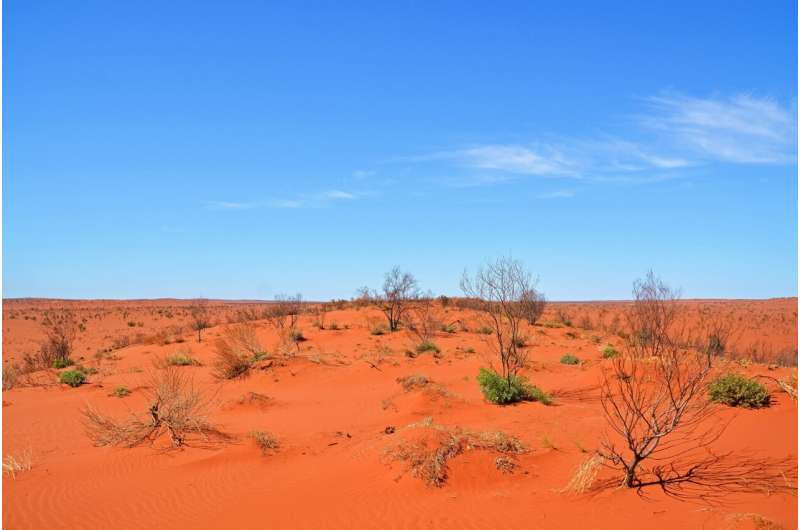Fossil plants reveal lush Southern Hemisphere forests in ancient hothouse climate

For decades, paleobotanist David Greenwood has collected fossil plants from Australia—some so well preserved it's hard to believe they're millions of years old. These fossils hold details about the ancient world in which they thrived, and Greenwood and a team of researchers including climate modeler and research David Hutchinson, from the University of New South Wales, and UConn Department of Geosciences paleobotanist Tammo Reichgelt, have begun the process of piecing together the evidence to see what more they could learn from the collection. Their findings are published in Paleoceanography & Paleoclimatology.
The fossils date back 55 to 40 million years ago, during the Eocene epoch. At that time, the world was much warmer and wetter, and these hothouse conditions meant there were palms at the North and South Pole and predominantly arid landmasses like Australia were lush and green. Reichgelt and co-authors looked for evidence of differences in precipitation and plant productivity between then and now.
Since different plants thrive under specific conditions, plant fossils can indicate what kinds of environments those plants lived in.
By focusing on the morphology and taxonomic features of 12 different floras, the researchers developed a more detailed view of what the climate and productivity was like in the ancient hothouse world of the Eocene epoch.
Reichgelt explains the morphological method relies on the fact that the leaves of angiosperms—flowering plants—in general have a strategy for responding to climate.
"For example, if a plant has large leaves and it is left out in the sun and doesn't get enough water, it starts to shrivel up and die because of excess evaporation," Reichgelt says. "Plants with large leaves also lose heat to its surroundings. Finding a large fossil leaf therefore means that most likely this plant was not growing in an environment that was too dry or too cold for excess evaporation or sensible heat loss to happen. These and other morphological features can be linked to the environment that we can quantify. We can compare fossils to modern floras around the world and find the closest analogy."
The second approach was taxonomic. "If you travel up a mountain, the taxonomic composition of the flora changes. Low on the mountain, there may be a deciduous forest that is dominated by maples and beeches and as you go further up the mountain, you see more spruce and fir forest," says Reichgelt. "Finding fossils of beech and maple therefore likely means a warmer climate then if we find fossils of spruce and fir." Such climatic preferences of plant groups can be used to quantitatively reconstruct the ancient climate in which a group of plants in a fossil assemblage was growing.
The results show that the Eocene climate would have been very different to Australia's modern climate. To sustain a lush green landscape, the continent required a steady supply of precipitation. Warmth means more evaporation, and more rainfall was available to move into Australia's continental interior. Higher levels of carbon dioxide in the atmosphere at the time, 1500 to 2000 parts per million, also contributed to the lushness via a process called carbon fertilization. Reichgelt explains that with the sheer abundance of CO2, plants were basically stuffing their faces.
"Southern Australia seems to have been largely forested, with primary productivity similar to seasonal forests, not unlike those here in New England today," Reichgelt says. "In the Northern Hemisphere summer today, there is a big change in the carbon cycle, because lots of carbon dioxide gets drawn down due to primary productivity in the enormous expanse of forests that exists in a large belt around 40 to 60 degrees north. In the Southern Hemisphere, no such landmass exists at those same latitudes today. But Australia during the Eocene occupied 40 degrees to 60 degrees south. And as a result, there would be a highly productive large landmass during the Southern Hemisphere summer, drawing down carbon, more so than what Australia is doing today since it is largely arid."
Hutchinson says the geological evidence suggests the climate is highly sensitive to CO2 and that this effect may be larger than what our climate models predict, "The data also suggests that polar amplification of warming was very strong, and our climate models also tend to under-represent this effect. So, if we can improve our models of the high-CO2 Eocene world, we might improve our predictions of the future."
Future projects will expand the data set beyond Australia to ask what global productivity does during a hothouse climate on a global scale.
"We have large datasets of plant fossils that have been collected around the world, so we can apply the same methods that we use here to ask what happens to global biosphere productivity," says Reichgelt.
With increasing carbon emissions, there is more research going into studying what happens in the biosphere with increased photosynthetic activity and water use efficiency in plants. Reichgelt explains that modern plants have not had the time to evolve to changing CO2 conditions. However, by looking to the past, we can glean some of that information.
"It obviously will take a long time for plants to adapt to changing CO2 levels, but fossil floras allow us to peek into the biosphere of ancient hothouse worlds."
More information: Tammo Reichgelt et al, Plant Proxy Evidence for High Rainfall and Productivity in the Eocene of Australia, Paleoceanography and Paleoclimatology (2022). DOI: 10.1029/2022PA004418
Provided by University of Connecticut





















